As Tusk closed out the first quarter of 2024, we took an opportunity to reflect on the activity, trends, and takeaways from the marketplace. After digging in, we discovered that Q1 2024 was the most active first quarter on record! When reflecting on past starts to the year, we quickly realized that 2024 was unique, and we wanted to understand why. This is where things get interesting …
In February 2024, we published an article predicting DSO activity would pick up due to the leveling off and potential lowering of interest rates and because some of the legacy DSOs that were “pencils down” in 2023 would have to come back to the table. Those predictions turned out to be spot on! Deals that went to market in Q1 2024 were received much better than deals that went to market Q1 2023. A hot 2024 was predicated on the fact that mergers and acquisitions (M&A) in 2023 was at a crawl compared to the years prior, and DSOs would need to pick up the pace to keep investors happy.
Looking back: the reality check
M&A activity in 2023 was slow because many DSOs and private equity (PE) groups didn’t anticipate the rapid rise of interest rates. Couple that with the fact that their trailing 12-month (TTM) performance was hindered by one of the toughest operating environments since the formation of DSOs. In 2022 and 2023, we saw rapid inflation in supply costs and labor expenses, and a very difficult hiring environment fueled by the great resignation. There were still new PE groups starting to invest in dentistry, and those new buyers offset some of the DSOs that went pencils down. However, we knew that once the legacy groups resumed their M&A activities, the market would heat up! That’s where we are today.
Discovering color in the gray
In 2024 we focused on legacy DSOs, which we define as groups backed by PE that have been in operation between three and 20 or more years. These are the groups that were largely pencils down because of interest rates and from margin compression from their core business due to inflation. Additionally, we focused on PE groups that were just starting their DSO in 2023 and were looking to gain scale fast through add-on acquisitions. What we missed is what was in the middle.
Race to the start line
There were several groups that were formed late in 2021, and a couple slightly more mature groups that were pencils down in 2022–2023 who came back to market faster than others. While digging in, we identified that each DSO had a different reason for coming back to market faster than other legacy DSOs. Those reasons ranged from new leadership and strategy to a recent infusion of capital at favorable terms that allowed them to put forth compelling offers. All of this benefited sellers because it allowed advisors to continue to create competitive processes for their clients in what was one of the most difficult M&A environments in the past 10–15 years.
Timing trumps temperature
Timing when you go to market is as important as anything else you can do when preparing your business for sale. It’s important that you hire an advisor who’s in touch with the market. In our experience, selling doctors who go to market in the second half of the year will have a very difficult time getting their deal done before the end of the year. The more time you have, the more control and greater negotiating power you have. It’s never too late to get educated on your practice’s value. A free practice valuation that allows you to unlock potential growth opportunities to maximize your value in a sale is a great place to start.
Editor's note: This article appeared in the April 2024 print edition of Dental Economics magazine. Dentists in North America are eligible for a complimentary print subscription. Sign up here.
Ryan Mingus, managing director of Tusk Practice Sales, has 12-plus years of sales and leadership experience in the dental and health-care industry, most recently as business development director for strategy and optimization at Align Technology. Mingus earned his BA in economics and business from the Virginia Military Institute and his MBA from the University of San Diego. He also held the rank of Captain in the US Army National Guard.









